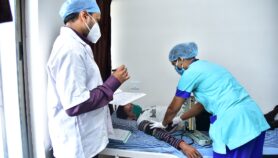By: Mićo Tatalović
Send to a friend
The details you provide on this page will not be used to send unsolicited email, and will not be sold to a 3rd party. See privacy policy.
Harvard globalisation professor Calestous Juma talks to SciDev.Net about how to get Africa’s wealth of innovation making an impact
Calestous Juma, director of the Science, Technology and Globalization Project at Harvard University’s Kennedy School of Government, has attracted plenty of attention for his recent book, The New Harvest: Agricultural Innovation in Africa, which sets out a vision of an Africa that can feed itself by 2050.
The book exudes the same optimism that emanated from his 2005 book on science for the Millennium Development Goals. Juma argues in both that a mix of existing knowledge and innovation could lead Africa out of poverty and hunger.
SciDev.Net caught up with him on a recent visit to London where he promoted his book.
Why are you so optimistic about African innovation?
I have worked on another project with colleagues at the University of Toronto, Canada, that looked at medical technologies. They were able to identify 25 very promising medical innovations that have been developed in Africa but were not reaching the market place, including drugs for malaria and other diseases, mostly extracted from indigenous plants.
So we see innovations emerging in the medical arena, which is fairly complex if it needs large investments.
We’ve seen innovation developing in the agricultural arena and some really interesting developments in the area of telecommunications, in unexpected ways — including the emergence of new industries like mobile money transfer.
That is an African invention, responding to poor banking services. And we’ve seen in the past some innovations in land use, particularly in the arena of soil conservation.
So if you look at different sectors you find really significant advances. What hasn’t been happening, in my view, is a clear recognition on the part of leaders that major institutional reforms are needed to promote the diffusion of new technologies into the economy.
So what’s holding back all these African innovations?
One thing is ideology. There is a general assumption, mostly informed by some economic theories, that, if the market is right, innovations will simply emerge and diffuse without requiring government support. And so the focus has been on liberalising economic systems and markets in the hope that innovations would just emerge on their own.
But we know, in fact, that innovations don’t just emerge — they are a product of deliberate private and public support systems which help them to move from the lab to the market place. They include institutions such as venture capital, technology development agencies to improve the technologies, and institutions that guarantee that those innovations are safe.

There have been really interesting developments in the area of telecommunications, Juma says
Flickr/kiwanja
In the food and drug areas, for example, institutions that foster public trust among consumers are essential for getting new products to market.
Many of those institutions don’t exist in Africa because the continent has predominantly relied on imported technologies from outside.
And that is really what is missing: it’s not the absence of creativity on the part of the population.
Who should be creating those institutions?
That’s something that has to be done by African governments themselves by legislation. For example, I went back to Kenya after finishing my PhD and helped to create a national intellectual property office. We wanted to promote a culture of creativity so young people could see what had been patented and be inspired to develop their own ideas.
But I couldn’t have done that if the government hadn’t been interested in taking the ideas and translating them into law. The patent office was created by the government.
The costs of creating these institutions are not very significant. Much of the cost involves putting up new buildings.
In Rwanda, for example, the government created the Kigali Institute of Science and Technology by converting military barracks to a learning institution. The National University of Namibia used former South African military facilities. The new Multimedia University of Kenya is located in what used to be the premises of the national agency for training telecoms regulators.
The cost of creating new technology-based firms is not that prohibitive either. Take Hehe as an example. This is a Rwanda start-up that provides mobile solutions to businesses, organisations and individuals. It took only US$30,000 to create this company — and a large part of that cost was to rent the server. That small company, created by recent graduates, is going to be a huge inspiration to other young people thinking about creating new technologies. In addition to local creativity, the other major input was collaboration with external universities such as MIT (the Massachusetts Institute of Technology).
Some institutions are being created now and interesting things are going on in the continent such as telecoms universities that are connected to the productive sector and embedded in the telecoms ministries.
They are functioning almost as technology development agencies — they do their own research and are also linked to the telecom suppliers — so when they develop a product they are able to commercialise it. Egypt, Ghana and Kenya have such universities and Tanzania and Nigeria are exploring the idea as well.



The Rwandan government created the Kigali Institute of Science and Technology by converting military barracks
Flickr/jon gos
So we’re starting to see these uniquely African models emerge: universities that are embedded in the ministries; that combine research, commercialisation and education under one roof. The issue is to take these models and extend them to other sectors such as agriculture and health.
Is there enough expertise within Africa to make these quality institutions?
When we created a patent office in Kenya, there were very few patent lawyers there. Now Kenya is supplying patent lawyers to other countries and international organisations. You can’t train people unless you’ve created an institution first, which sends a signal to the community that this field is important — then you see people studying in those areas.
The fate of the Nigerian sickle cell drug, Nicosan demonstrated that, even after a drug is developed, it may fail.
That’s a very good example of the absence of the complementary institutions needed to get products to market. When Nigeria developed the drug it couldn’t find venture capital to commercialise it or to invest in manufacturing or distribution. It’s a good example of systems failure downstream.
Should African higher education change to foster innovation?
The three telecom universities are a good indicator of what could be done. Other technical ministries should create such universities. In Kenya, the ministries of energy and roads are in the process of considering similar institutions.
Graduates from these universities would have had exposure to practical activities and when they graduate they will go to work on practical issues — the link to the government department and the private sector will almost guarantee them a job.
Traditional universities don’t have these connections, students don’t even do practical internships. For example, agriculture graduates have little practical exposure so the agricultural sector could also benefit.
India found its higher education system to be too rigid for reform so it put forward a new law to create ‘universities for innovation’. This is being done under the guidance of a new National Innovation Council advising the prime minister. This is a model that African countries should look at because reforming existing universities is much harder than creating new ones.
But first a new law, with separate incentive structures [that encourage innovation and the transmission of new knowledge] has to be created — otherwise even new universities will simply conform to the old law



Juma says his new book will explore green technologies for areas such as agriculture
Flickr/Peter Casier
Is there a danger in promoting innovation when basic standards, and infrastructures, are not in place?
Innovation is essential for meeting basic needs — and building infrastructure is essential for innovation. These institutions haven’t been updated because we haven’t paid sufficient attention to the importance of innovation. One of the earliest inventions coming out of Africa was in the 1980s when a Zimbabwean scientist developed a DNA diagnostic kit for detecting Salmonella. Because supporting institutions were not in place he could not commercialise it, although it had the potential to reach a global market.
Such examples of lack of capacity to detect emerging diseases reinforce the case for investing more in innovation rather than less.
What else blocks African innovation?
Incumbency. Legal incumbency. Existing government structures that focus on departmental mandates are not conducive to innovation. They are slow to reform because of vested interests.
For example, the separation between research and teaching is a major barrier to research in Africa. In many African countries research is carried out in national research institutes by people who do not teach so the knowledge is not being passed on. Then there are universities, which teach but don’t do research, so they don’t use new knowledge. Both of them degrade over time.
This separation is actually provided for in the laws of these countries, and reforming those laws is the most difficult challenge. Ministers see themselves as being there to implement the law, researchers are only interested in getting funding for their research — they don’t want the burden of teaching. And so this barrier remains.
Presidents are starting to take an interest in this but no country has yet changed its laws. When you change the laws you also change the structure of incentives and political benefits and people oppose it. In Kenya, for example, the draft science law has been around for five years now.
Changing these laws needs acts of political leadership.
Are you working on any new projects?
Yes, I am working on a book about green technologies: how we can get a continent like Africa, which has not invested heavily in traditional technologies, to start thinking about leapfrogging into the world of new technologies in energy, agriculture, water use and cleaner manufacturing practices. I am also updating my thinking on innovation policy for Africa in a new book.
More on Capacity building


Script media release
Journalists offered ‘big break’ mentoring opportunity from Radio Nigeria
03/04/19












